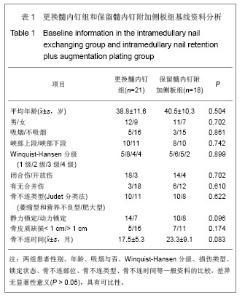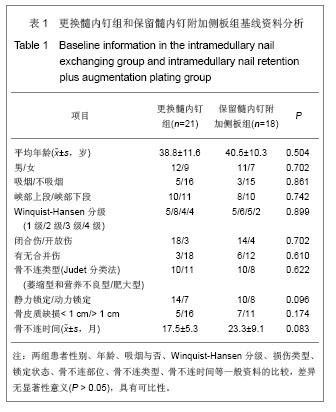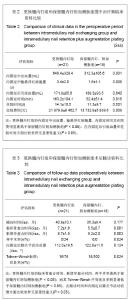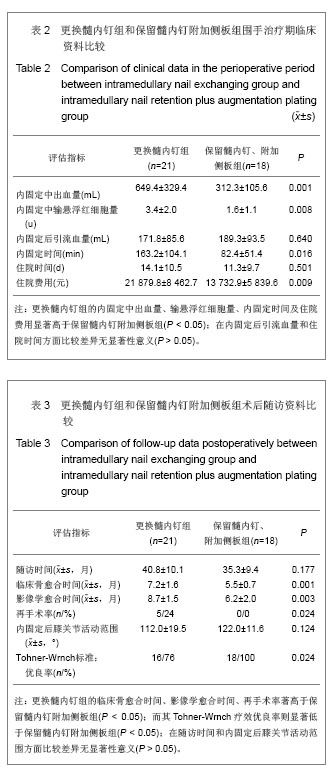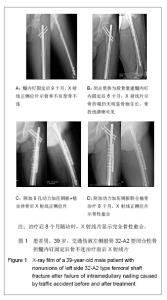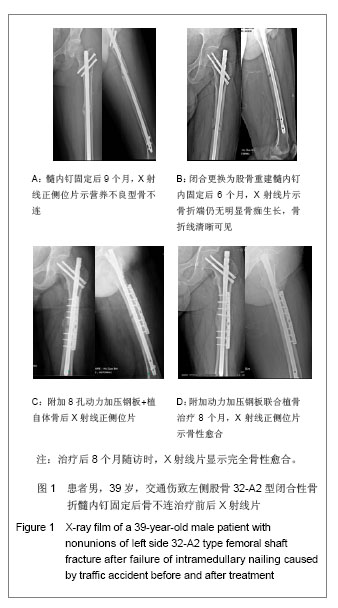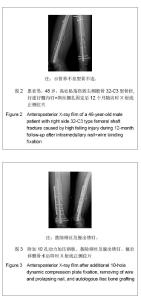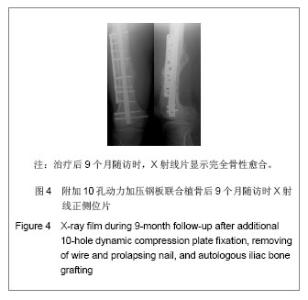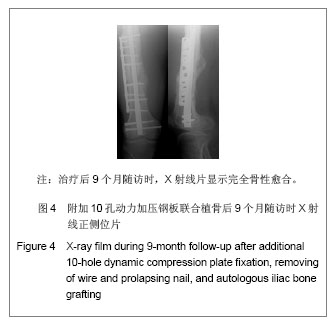| [1]Pihlajamäki HK, Salminen ST, B?stman OM.The treatment of nonunions following intramedullary nailing of femoral shaft fractures.J Orthop Trauma. 2002;16(6):394-402.
[2]Oh JK, Bae JH, Oh CW, et al.Treatment of femoral and tibial diaphyseal nonunions using reamed intramedullary nailing without bone graft. Injury. 2008;39(8):952-959.
[3]Brinker MR,O'Connor DP.Exchange Nailing of Ununited Fractures. J Bone Joint Surg Am.2007,89:177-188 .
[4]张建政,刘智,孙天胜,等.附加钢板治疗髓内钉固定后股骨萎缩性骨不连[J].中华创伤杂志,2011,27(5):451-455.
[5]Park J, Kim SG, Yoon HK, et al.The treatment of nonisthmal femoral shaft nonunions with im nail exchange versus augmentation plating. J Orthop Trauma. 2010 Feb;24(2):89-94.
[6]赵刚,张伯松,孙林,等.带锁髓内钉治疗股骨干骨折术后旋转不稳定所致不愈合的诊断和治疗[J].中华外科杂志,2009,47(16): 1232-1235.
[7]李宝文,王东昕,李学良,等.股骨干骨折术后不愈合25例临床分析[J].中国修复重建外科杂志,2008,22(6):763-764.
[8]刘振东.扩髓换钉治疗股骨干无菌性骨不连[J].中华创伤骨科杂志, 2005,7(5):470-472
[9]李衡,张奉琪,任栋,等.股骨干骨折带锁髓内钉固定后不愈合的治疗[J].中华骨科杂志,2005,24(8):476-480.
[10]Lin CJ, Chiang CC,Wu PK,et al. Effectiveness of plate augmentation for femoral shaft nonunion after nailing. J Chin Med Assoc.2012;75(8):396-401.
[11]Said GZ, Said HG, el-Sharkawi MM.Failed intramedullary nailing of femur: open reduction and plate augmentation with the nail in situ. Int Orthop. 2011;35(7):1089-1092.
[12]Lambiris E,Panagopoulos A,Zouboulis P,et al.Current concepts:aseptic nonunion of femoral shaft diaphysis.Eur J Trauma Emerg Surg,2007;33(2):120-134.
[13]Choi YS, Kim KS. Plate augmentation leaving the nail in situ and bone grafting for non-union of femoral shaft fractures. Int Orthop. 2005;29(5):287-290.
[14]Johner R, Raccaud O, Dournow J. Standard radiological study of the knee. Rev Med Suisse Romande. 1994;114(4): 335-341.
[15]Court-Brown CM,Keating JF,Ch istie J,et al. Exchange intramedullary nailing. Its use in aseptic tibial nonunion. J Bone Joint Surg Br.1995;77:407-411.
[16]Bhandari M,Schemitsch EH. Bone formation following intramedullary femoral reaming is decreased by indomethacin and antibodies to insulin-like growth factors. J Orthop Trauma. 2002;16:717-722 .
[17]Banaszkiewicz PA, Sabboubeh A, McLeod I, et al. Femoral exchange nailing for aseptic non-union: not the end to all problems.Injury.2003;34(5):349-356.
[18]Weresh MJ,Hakanson R,Stover MD,et al.Failure of exchange reamed intramedullary nails for ununited femoral shaft fractures. J Orthop Trauma.2000;14:335-338.
[19]Ueng SW, Chao EK, Lee SS, et al. Augmentative plate fixation for the management of femoral nonunion after intramedullary nailing. J Trauma. 1997;43(4):640-644.
[20]Park K, Kim K, Choi YS. Comparison of mechanical rigidity between plate augmentation leaving the nail in situ and interlocking nail using cadaveric fracture model of the femur. Int Orthop.2011;35(4):581-585.
[21]Lynch JR, Taitsman LA, Barei DP,et al.Femoral nonunion: risk factors and treatment options. J Am Acad Orthop Surg.2008; 16(2):88-97.
[22]茹江英,仓海滨,胡传亮,等.附加侧板联合植骨治疗股骨干骨折髓内钉固定后骨不连[J].中国组织工程研究,2013,17(4):604-611.
[23]李福春,谷贵山,金成浩,等.更换髓内钉治疗股骨干骨折髓内钉内固定术后骨不连:12例资料回顾性分析[J].中国组织工程研究与临床康复,2007,11(47):9584-9586.
[24]Shroeder JE, Mosheiff R, Khoury A, et al. The outcome of closed, intramedullary exchange nailing with reamed insertion in the treatment of femoral shaft nonunions. J Orthop Trauma. 2009;23(9):653-657.
[25]李冀,赵伟超,关鹏飞,等.长骨医源性骨不连的临床流行病学调查[J].中国骨与关节损伤杂志,2012,27(1):34-36.
[26]刘璠,祁俊.骨折不愈合与延迟愈合的成因与治疗[J].中华创伤骨科杂志,2005,7(5):405-408.
[27]王秋根,高堪达,高伟,等.下肢髓内钉术后非感染性骨不连的对策:内植骨结合阻挡钉技术[J].中国矫形外科杂志,2009,16(14): 1045-1047.
[28]Nadkarni B, Srivastav S, Mittal V, et al. Use of locking compression plates for long bone nonunions without removing existing intramedullary nail: review of literature and our experience. J Trauma.2008;65(2):482-486.
[29]刘智,李连华,孙天胜,等.附加钢板与交锁髓内钉治疗下肢长骨干骨折后肥大性骨
[30]张建政,孙天胜,刘智,等.更换髓内钉与保留髓内钉附加钢板治疗髓内钉固定后股骨肥大性骨不连[J].中华骨科杂志,2011,31(9): 949-954. |
